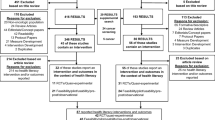Abstract
Lung cancer survivors are likely to have low health literacy which is an independent risk factor for poorer health outcomes. The eHealth literacy in lung cancer survivors has not been reported. The purposes of this study were to determine self-perceived eHealth literacy levels in lung cancer survivors and to explore predictors of higher eHealth literacy. A cross-sectional study was conducted at the Princess Margaret Cancer Centre in Toronto, Canada. Survivors completed a survey that collected demographic, self-perceived eHealth literacy (using the eHealth Literacy Scale), and quality of life information. Tumor and treatment details were extracted from medical records. Demographic data was summarized using descriptive statistics and compared against those with high and low eHealth literacy using Fisher’s exact test. Eighty-three survivors were enrolled over 7 months. Median age was 71 years (range 44–89); 41 survivors (49 %) were male. Forty-six (55 %) survivors had some college education or higher. Most had access to eResources (78 %) via computer, Internet, or smartphone. Fifty-seven (69 %) scored 5 or greater (7 = excellent) on the overall health scale. Twenty-eight (33.7 %) perceived themselves to have high eHealth literacy. There was no statistically significant correlation between eHealth literacy groups and age (p = 1.00), gender (p = 0.82), living situation (p = 1.00), overall health (p = 1.00), overall quality of life (QoL) (p = 1.00), or histology (p = 0.74). High eHealth literacy correlated with the level of education received (p = 0.003) and access to eResources (p = 0.004). The self-perceived eHealth literacy of lung cancer survivors is generally low.
Similar content being viewed by others
References
Koay K, Schofield P, Gough K et al (2013) Suboptimal health literacy in patients with lung cancer or head and neck cancer. Support Care Cancer 21:2237–2245
Koay K, Schofield P, Jefford M (2012) Importance of health literacy in oncology. Asia Pac J Clin Oncol 8:14–23
Eysenbach G (2003) The impact of the Internet on cancer outcomes. CA Cancer J Clin 53(6):356–371
Eng TR (2001) The eHealth landscape: a terrain map of emerging information and communication technologies in health and health care. Robert Wood Johnson Foundation, Princeton, NJ
Bennett GG, Glasgow RE (2009) The delivery of public health interventions via the Internet: actualizing their potential. Annu Rev Public Health 30:273–292
Berland GK, Elliott MN, Morales LS et al (2001) Health information on the Internet: accessibility, quality, and readability in English and Spanish. JAMA 285(20):2612–2621
Norman CD, Skinner HA (2006) eHealth literacy: essential skills for consumer health in a networked world. J Med Internet Res 8(2):e9
Baker DW (2006) The meaning and the measure of health literacy. J Gen Intern Med 21(8):878–883
Mancuso JM (2009) Assessment and measurement of health literacy: an integrative review of the literature. Nurs Health Sci 11(1):77–89
Xie B (2011) Effects of an eHealth literacy intervention for older adults. J Med Internet Res 13(4):e90
Robinson C, Graham J (2010) Perceived Internet health literacy of HIV-positive people through the provision of a computer and Internet health education intervention. Health Info Libr J 27(4):295–303
Knapp C, Madden V, Wang H et al (2011) Internet use and eHealth literacy of low-income parents whose children have special health care needs. J Med Internet Res 13(3):e75
Mitsutake S, Shibata A, Ishii K et al (2012) Association of eHealth literacy with colorectal cancer knowledge and screening practice among internet users in Japan. J Med Internet Res 14(6):e153
American Cancer Society (2012) Cancer facts & figures 2012. American Cancer Society, Atlanta
Sturgis EM, Wei Q, Spitz MR (2004) Descriptive epidemiology and risk factors for head and neck cancer. Semin Oncol 31:726–733
Neter E, Brainin E (2012) eHealth literacy: extending the digital divide to the realm of health information. J Med Internet Res 14(1):e19
Aaronson NK, Ahmedzai S, Bergman B et al (1993) The European Organisation for Research and Treatment of Cancer QLQ-C30: a quality-of-life instrument for use in international clinical trials in oncology. J Natl Cancer Inst 85:365–376
Norman C, Skinner H (2006) eHEALS: the eHealth literacy scale. J Med Internet Res 8(4):e27
Skinner H, Biscope S, Poland B (2003) Quality of Internet access: barrier behind internet use statistics. Soc Sci Med 57(5):875–880
Birru M, Monaco V, Charles L et al (2004) Internet usage by low-literacy adults seeking health information: an observational analysis. J Med Internet Res 6(3):e25
Van der Varrt R, van Deursen A, Drossaert C et al (2011) Does the eHealth literacy scale (eHEALS) measure what it intends to measure? Validation of a Dutch version of the eHEALS in two adult populations. J Med Internet Res 13(4):e86
Norman CD (2009) Skills essential for eHealth. In: Hernandez LM (ed) Health literacy, eHealth, and communication: putting the consumer first: workshop summary. National Academies Press, Washington, DC
Palma D, Visser O, Lagerwaard FJ et al (2010) Impact of introducing stereotactic lung radiotherapy for elderly patients with stage I non-small-cell lung cancer: a population-based time-trend analysis. J Clin Oncol 28(35):5153–5159
Ad Hoc Committee on Health Literacy for the Council on Scientific Affairs (1999) American Medical Association Health literacy: report of the Council on Scientific Affairs. JAMA 281(6):552–557
Osborn CY, Paasche-Orlow MK, Bailey SC et al (2011) The mechanisms linking health literacy to behavior and health status. Am J Health Behav 35(1):118–128
Acknowledgments
Permission to use the eHEALS tool was granted by its authors.
Conflict of Interest
Robin Milne, Martine Puts, Janet Papadakos, Lisa Le, Victoria Milne, Andrew Hope, Pamela Catton, and Meredith Giuliani declare that they have no conflict of interest.
Author information
Authors and Affiliations
Corresponding author
Rights and permissions
About this article
Cite this article
Milne, R.A., Puts, M.T.E., Papadakos, J. et al. Predictors of High eHealth Literacy in Primary Lung Cancer Survivors. J Canc Educ 30, 685–692 (2015). https://doi.org/10.1007/s13187-014-0744-5
Published:
Issue Date:
DOI: https://doi.org/10.1007/s13187-014-0744-5




